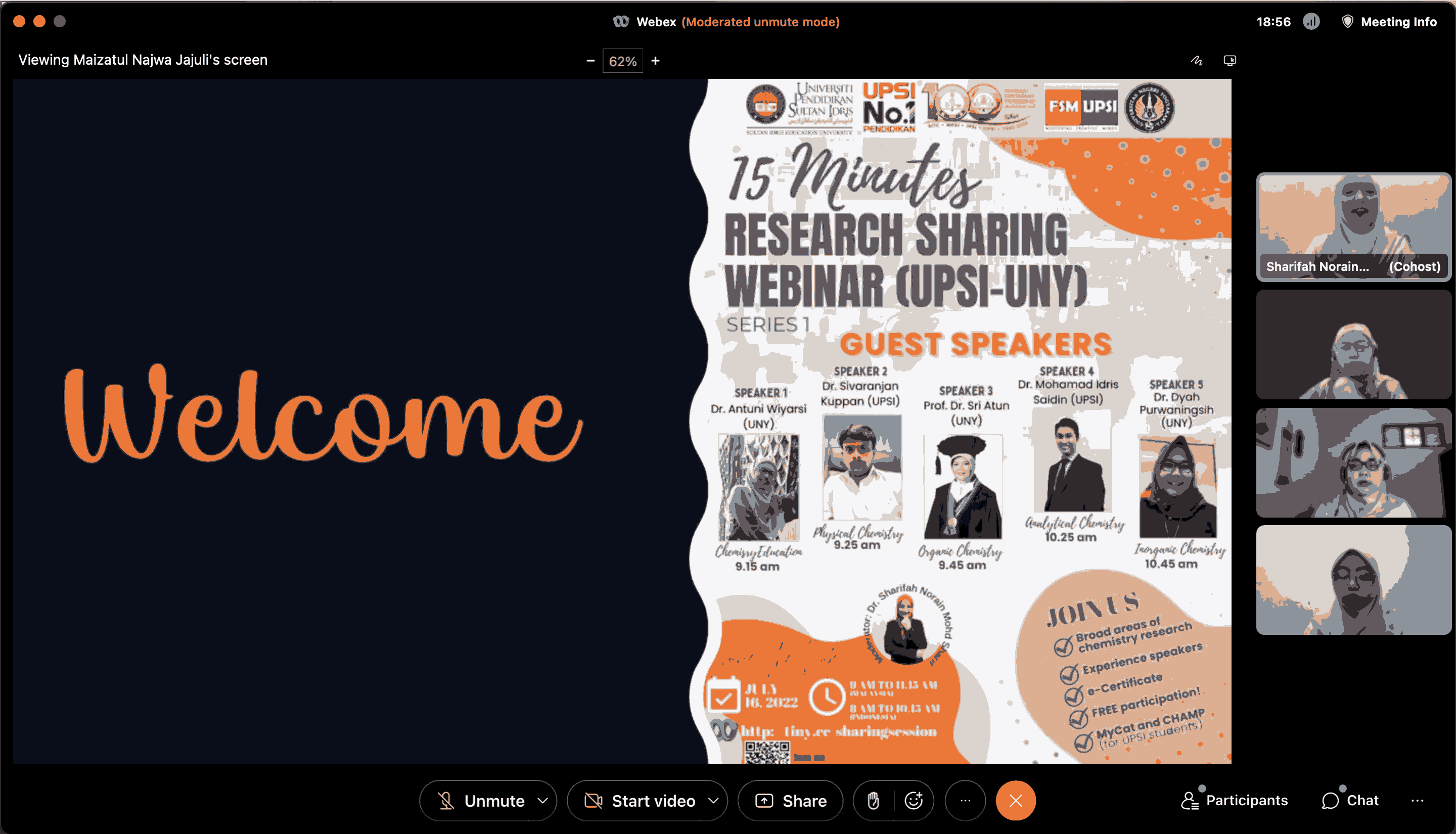You are here
UPSI-UNY Research Sharing Webinar

On Saturday, 16 July 2022, the Chemistry Education Department of State University of Yogyakarta (UNY) held a joint webinar with the Chemistry Department of Sultan Idris Education University of Education (UPSI), Malaysia. There were 5 guest speakers who participated in this webinar with 3 of them being lecturers of the Department of Chemistry Education from UNY namely Dr. Antuni Wiyarsi, M.Sc. (Chemistry Education), Prof. Dr. Sri Atun (Organic Chemistry), and Dr. Dyah Purwaningsih (Inorganic Chemistry) and 2 others were lecturers of the UPSI Chemistry Department namely Dr. Sivaranjan Kuppan (Physical Chemistry) and Dr. Mohammad Idris (Analytical Chemistry).
Dr Antuni Wiyarsi, M.Sc. presented about Research on Socioscientific Issue to Improve Chemistry Learning Relevance. In her session, Dr Antuni explained that there is no universal agreement on scientific issues related to SSI, but an issue can be said to be SSI if it involves at least 2 disagreements from 2 different groups. As for understanding SSI, it requires: (1) conceptual knowledge, (2) reaction + reflection, and (3) dilemma + decision. As an issue, SSI in chemistry learning can be used to explore how students to think like scientists. Therefore, the use of SSI in chemistry learning can develop Scientific Habits of Mind (SHOM), argumentation skills, chemistry literacy, etc. One way to apply SSI in chemistry
learning is to use context-based learning. The use of SSI context-based chemistry learning is expected to increase the relevance of chemistry to students' lives in accordance with the meaning of chemistry relevance which determines the perception of significance by providing real-life effects for individuals in a multidimensional manner.
The second speaker was Dr Sivaranjan Kuppan from UPSI. He discussed about nanocomposite and nanoparticle in physical chemistry research as catalytic activity study. In his finding, Dr Sivranjan used SEM and TEM in conducting analysis based on particle size differences.
The third speaker was Prof. Dr. Sri Atun from UNY who talked about Phytochemical of Some Tropical Traditional Plant and Its Development to Find New Material Drugs. In her presentation, Prof Atun said that there are many traditional plants in the tropics that can be used and developed into new materials to make medicines, including the following.
-
Gandapura oil containing methyl salicylate can be esterified into salicylic acid and acetyl salicylate, which is the main ingredient used for medicine for headaches.
-
Cloves containing eugenol that can be developed into various ingredients for cosmetics, perfumes, pest control.
-
Quinine which contains quinine which has long been used for malaria drugs but it causes resistance so from quinine then synthesised into quindine which is useful for heart disease drugs
-
Taxol from taxus brevifolia can be used for breast cancer drugs
The fourth speaker was Dr Mohammad Idris from UPSI of Analytical Chemistry. Dr Idris stated that analytical chemistry basically involves qualitative and quantitative analysis. The research in this field originated from various problems such as problems about cosmetics containing mercury, the dangers of excessive use of paracetamol, the sale of baby milk bottles that are not free of BPA (Bisphenol A) which causes resistance and cancer. Aiming to identify these dangerous chemical compounds requires modern chemical instrumentation such as HPL, AAS, GC-MS, ICP-OES, and even mercury analysers. However, operating such instruments has several disadvantages, namely: (1) time consuming, (2) sophisticated, (3) requires operator certification, (4) expensive, and (5) requires sample treatment. Therefore, Dr Idris and his team formulated to use electrochemical sensors in the form of voltammetry.
The last speaker was Dr Dyah Purwaningsih from UNY. Dr Dyah discuss about the Development of Cathode Materials for Lithium Ion-Batteries. Her research is based on the fact that the use of batteries is inseparable from everyday life but the waste generated from batteries is quite harmful to the environment. Therefore, Dr Dyah and her research team used MnO2 compounds to develop lithium ion batteries. The use of MnO2 is very potential because it is very abundant, cheap, and environmentally friendly. Through this joint webinar activity, it is hoped that it can provide new insights regarding research topics in various fields of chemistry and chemistry education.
Information System
Kontak Kami
Program Studi Kimia
FMIPA Universitas Negeri Yogyakarta
Kampus Karangmalang Yogyakarta 55281
Telp. (0274)586168 Pes. 115
Email: kimia@uny.ac.id atau s1kimia@uny.ac.id
Copyright © 2025,
